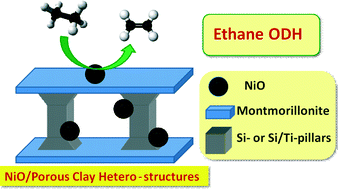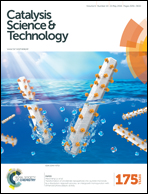Nickel oxide supported on porous clay heterostructures as selective catalysts for the oxidative dehydrogenation of ethane†
Abstract
Porous clay heterostructures (PCH) have shown to be highly efficient supports for nickel oxide in the oxidative dehydrogenation of ethane. Thus NiO supported on silica with a PCH structure shows productivity towards ethylene three times higher than if NiO is supported on a conventional silica. This enhanced productivity is due to the increase in the catalytic activity and especially to the drastic increase in the selectivity to ethylene. Additionally, PCH silica partially modified with titanium in the columns (PCH-Ti) have also been synthesized and used as supports for NiO. An enhanced activity and selectivity to ethylene was found over NiO supported over PCH-Ti compared to the corresponding catalysts supported over the Ti-free PCH. The enhanced catalytic performance has been related to the high dispersion of nickel oxide particles on the support, which leads to a lower reducibility of the nickel oxide, hindering the oxidation of ethane into carbon oxides. More interestingly, the particle morphology plays an important role on the catalyst selectivity since a higher distortion of the NiO crystal lattice parameter meant an enhanced selectivity to ethylene.


 Please wait while we load your content...
Please wait while we load your content...